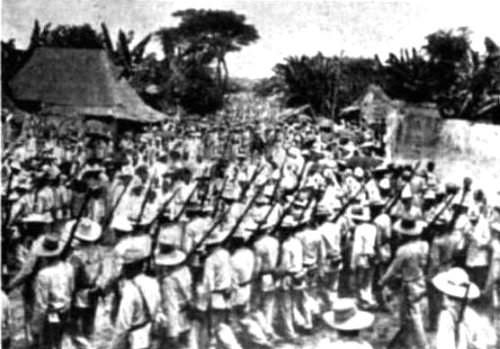
By the last day of March 1899, the leadership of the Philippine Republic in Malolos was under attack by the Americans and was retreating to a temporary capital in the north. The Philippine forces (in photo) could no longer prevent the Americans from capturing Malolos. Photo rom Wikimedia Commons
The month of March 1899 began with the continued optimism of the Malolos Republic. The leadership of the First Philippine Republic, inaugurated on Jan. 23, 1899, was safe and sound at the Philippine capital in Bulacan Province. The fighting between the Philippine and American forces were miles away.
However, by the last day of March 1899, the leadership of the Philippine Republic in Malolos was under attack by the Americans and was retreating to a temporary capital in the north. The Philippine forces could no longer prevent the Americans from capturing Malolos. By 11 a.m. on March 31, 1899, the former Philippine capital was under American control.
During the intense and bloody fighting between the Americans and Filipinos from March 25 to March 31, 1899, President Emilio Aguinaldo made a fateful decision. Should he make a last stand at the gates of Malolos? Should the Malolos Republic and its armed forces retreat to the north across the Rio Grande River? President Aguinaldo decided that Filipinos should live to fight another day. He chose to retreat and regroup his forces. The war was far from over.
For the American and Philippine troops, the first day of March began the same as it did on Feb. 6, 1899. The men were primarily still in the same trenches north of Manila. The Americans had made significant gains north of Manila on Feb. 5 and 6, but they were ordered to halt and dig in. They waited impatiently for orders to advance. There was a counterattack by General Luna on Feb. 22 to 24, which was repelled by the Americans.
The orders to advance did not come until March 25, 1899. With the delay, there were six weeks of high anxiety, fear and pressure on both sides. There was no calm and peace during this six-week period. There was deadly sniper fire every day for a careless soldier. Admiral Dewey’s ships in Manila Bay routinely fired on Filipino trenches. Both Americans and Filipinos fired field artillery at each other’s positions.
There was some consolation for the American soldiers. March 1, 1899, was payday for the U.S. soldiers. They were paid in gold coins at the front lines. The paymaster with a sizable armed escort delivered the compensation to the soldiers. In short order, the American soldiers were rotated to Manila for a few hours of liberty to spend some or all their gold coins.
The American soldiers at the front lines also had very good rations. Almost daily, fresh meat and bread were delivered to the entrenchments. The U.S. soldiers also received a steady supply of letters and packages from home. The soldiers lacked writing paper to respond to their mail, so they used paper wrappers from ammunition cartridges.
There were routine attacks by Philippine guerrillas on the soldiers who brought the meat, bread and mail by wagons from Manila to the American front lines. The guerrillas were behind American lines. There was a combination of conventional and guerrilla war at this time during the Philippine-American War.
When the U.S. generals ordered their troops to advance on March 25, 1899, they were satisfied that enough American troops had arrived in the Philippines. The generals also thought that the logistics were in place for the advance. General Elwell Otis was the commander for the northern offensive, and General Henry Lawton oversaw the southern offensive.
General Lawton made rapid progress to the south. He captured several towns in Cavite and Laguna. The U.S. Navy at Sangley Point aided the advance with gunboats, which were tactically beneficial in areas with rivers, streams and other bodies of water.
The American advance to the north commenced at 5:30 a.m. on March 25, 1899. The Americans basically followed the Manila to Dagupan Railroad to the north. There were heavy losses on both sides. The Philippine troops were solidly entrenched in several areas.
The Battle of Tullahan River occurred from March 25 to March 26, 1899. The battle included the capture of Polo, Malabon, Caloocan and other towns. The Battle of Marilao River happened on March 27, 1899 in Marilao, Bulacan Province. The Americans won both battles, but their logistical support was lagging due to the crossing of rivers and streams.
In the early morning of March 31, 1899, the Americans had reached the outskirts of Malolos. The American field artillery fired into Malolos for several hours. When the shelling stopped, the Americans entered the capital with little resistance. The capital was now in American hands. General Arthur MacArthur wanted to pursue the Philippine soldiers immediately, but his superior, General Otis, ordered him to stop and regroup.
The news of the capture of Malolos made General Otis ecstatic. He thought that the war was probably over, and that Aguinaldo would surrender shortly. He never thought that he was only at the beginning phase of the war. There were at least two more years of fighting.
Dennis Edward Flake is the author of three books on Philippine-American history. He is Public Historian and a former park ranger in interpretation for the National Park Service at the Eisenhower National Historic Site in Gettysburg, PA. He can be contacted at: flakedennis@gmail.com

